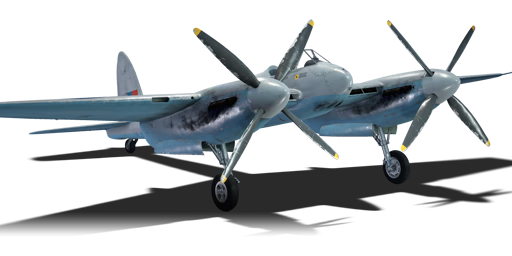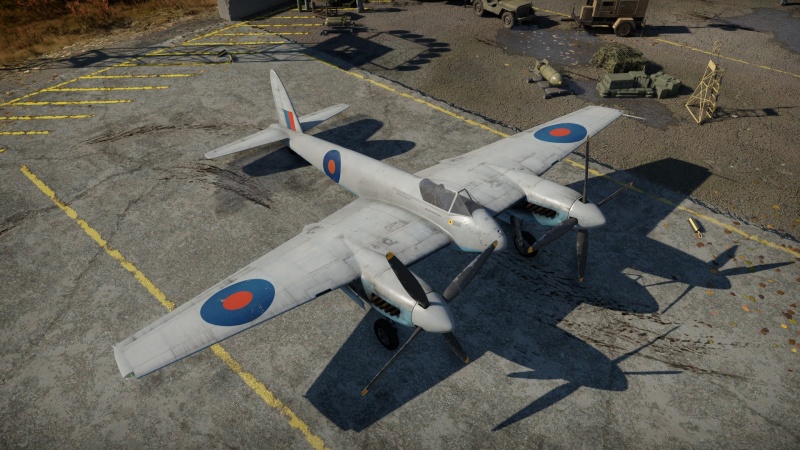Hornet Mk.I
| This page is about the premium British twin-engine fighter Hornet Mk.I. For the regular version, see Hornet Mk.III. |
Contents
Description
The Hornet Mk.I is a premium rank IV British twin-engine fighter with a battle rating of 5.3 (AB), 6.0 (RB), and 5.7 (SB). It was introduced in Update "Hot Tracks".
General info
Flight performance
For pilots who loved the Mosquito, the Hornet is a dream come true. As a descendant of the Mosquito FB Mk VI, it maintains many similarities to its older brother, namely an all-wooden construction and the iconic de Havilland tail design. However, the Hornet somehow managed to improve on the already excellent Mosquito platform, increasing speed, manoeuvrability and armament while reducing overall aircraft proportions. From takeoff and into its flight, the Hornet is an overall smooth operator with brutal speed, reaching easily over 600 km/h in level flight at 4,000 m, insane climb rate, and excellent manoeuvrability for a twin-engined fighter. However, it's still a twin-engined fighter which means it can still be outmanoeuvred by most single-engined opponents it faces. Being a predecessor to the regular tech-tree variant Hornet Mk.III, its flight performance is slightly worse but barely noticeable.
The consideration in buying this plane should rely on the experience already gathered with other twin-engined fighters, although when flying this plane is mastered, it's excellent at grinding out the British prop-ranks.
| Characteristics | Max Speed (km/h at 5,791 m) |
Max altitude (metres) |
Turn time (seconds) |
Rate of climb (metres/second) |
Take-off run (metres) | |||
|---|---|---|---|---|---|---|---|---|
| AB | RB | AB | RB | AB | RB | |||
| Stock | 716 | 696 | 11500 | 26.4 | 27.5 | 19.1 | 19.1 | 500 |
| Upgraded | 804 | 756 | 24.0 | 25.0 | 34.3 | 25.2 | ||
Details
| Features | ||||
|---|---|---|---|---|
| Combat flaps | Take-off flaps | Landing flaps | Air brakes | Arrestor gear |
| ✓ | ✓ | ✓ | X | X |
| Limits | ||||||
|---|---|---|---|---|---|---|
| Wings (km/h) | Gear (km/h) | Flaps (km/h) | Max Static G | |||
| Combat | Take-off | Landing | + | - | ||
| 826 | 324 | 370 | 356 | 287 | ~9 | ~4 |
| Optimal velocities (km/h) | |||
|---|---|---|---|
| Ailerons | Rudder | Elevators | Radiator |
| < 420 | < 390 | < 450 | > 324 |
Survivability and armour
- 38 mm bulletproof glass - armoured windscreen
- 12.7 mm steel plate in front of cockpit
- 12.7 mm steel plate behind pilot
- 2 x 3mm steel box behind the cockpit
- All fuel is stored in the wings
- All critical components are in the front of the aircraft, with only tail controls in the rear
Modifications and economy
Armaments
Offensive armament
The Hornet Mk.I is armed with:
- 4 x 20 mm Hispano Mk.V cannons, chin-mounted (190 rpg = 760 total)
Suspended armament
The Hornet Mk.I can be outfitted with the following ordnance:
- Without load
- 2 x 500 lb G.P. Mk.IV bombs (1,000 lb total)
- 2 x 1,000 lb M.C. Mk.I bombs (2,000 lb total)
- 8 x AP Mk I rockets
- 8 x AP Mk II rockets
- 8 x RP-3 rockets
- 2 x 500 lb G.P. Mk.IV bombs + 4 x AP Mk I rockets (1,000 lb total)
- 2 x 500 lb G.P. Mk.IV bombs + 4 x AP Mk II rockets (1,000 lb total)
- 2 x 500 lb G.P. Mk.IV bombs + 4 x RP-3 rockets (1,000 lb total)
- 2 x 1,000 lb M.C. Mk.I bombs + 4 x AP Mk I rockets (2,000 lb total)
- 2 x 1,000 lb M.C. Mk.I bombs + 4 x AP Mk II rockets (2,000 lb total)
- 2 x 1,000 lb M.C. Mk.I bombs + 4 x RP-3 rockets (2,000 lb total)
Usage in battles
Being a twin-engine fighter, it handles rather poorly when compared to single-engined fighters. It should not be expected to outmanoeuvre enemies, therefore you should really rely on your speed and try to keep you energy advantage. It might be possible to lure enemies into various manoeuvres where the excellent acceleration can be used to your advantage. If you have any experience from similar fighters like the Hornet Mk.III or any Mosquito, you can heavily use that to you advantage. Because the Hornet is an all-wooden construction, its ripping speed and maximum wing overload is rather low compared to other fighters.
When engaging fighters, a BnZ-playstyle should be used. One shouldn't commit to turning with the engaged enemy, because almost every plane, even light bombers will outturn you. The 4x Hispano Mk.Vs mounted in the front of the plane with an ammo pool of 190 rounds per gun, provide excellent firepower. The Hornet should be flown near friendlies because even when it can't get its guns on target, the enemy planes need to evade the bullets, therefore being an easy target to get picked off by allied planes nearby.
Because of its excellent climb rate, the Hornet can also be used as a bomber hunter. In his role, the main focus should lie on getting altitude to engage bombers from above, with far more speed than them. Do not try to spray your guns whilst being near the rear of the bomber, instead focus on one wing, then disengage after you've stricken the bomber.
Manual Engine Control
| MEC elements | ||||||
|---|---|---|---|---|---|---|
| Mixer | Pitch | Radiator | Supercharger | Turbocharger | ||
| Oil | Water | Type | ||||
| Controllable | Controllable Auto control available |
Not controllable Not auto controlled |
Controllable Auto control available |
Combined | Controllable 2 gears |
Not controllable |
Pros and cons
Pros:
- Excellent armament
- Very good climb rate
- Very fast, especially at high altitude
Cons:
- Poor roll and turn rates
- Wooden frame is vulnerable to fires and damage dealt from enemies
- Easily catches fire, the wings are littered with fuel tanks
History
Describe the history of the creation and combat usage of the aircraft in more detail than in the introduction. If the historical reference turns out to be too long, take it to a separate article, taking a link to the article about the vehicle and adding a block "/History" (example: https://wiki.warthunder.com/(Vehicle-name)/History) and add a link to it here using the main template. Be sure to reference text and sources by using <ref></ref>, as well as adding them at the end of the article with <references />. This section may also include the vehicle's dev blog entry (if applicable) and the in-game encyclopedia description (under === In-game description ===, also if applicable).
Media
- Skins
See also
Links to the articles on the War Thunder Wiki that you think will be useful for the reader, for example:
- reference to the series of the aircraft;
- links to approximate analogues of other nations and research trees.
External links
Paste links to sources and external resources, such as:
- topic on the official game forum;
- other literature.
| De Havilland Aircraft Company Limited | |
|---|---|
| Fighters | Hornet Mk.I · Hornet Mk.III · Mosquito FB Mk VI · Mosquito FB Mk XVIII |
| Jet fighters | Vampire F.B.5 · Venom FB.4 · Sea Venom FAW 20 · Sea Vixen F.A.W. Mk.2 |
| Export | ␗Mosquito FB.Mk.26 · ▄Vampire FB 52A(Italy) · ▄Vampire FB 52A(Finland) · A28B |
| Britain premium aircraft | |
|---|---|
| Fighters | Tuck's Gladiator Mk II · ▄Boomerang Mk I · ▄Boomerang Mk II · ▄D.520 |
| ▄Martlet Mk IV · ▄Corsair F Mk II · ▄Hellcat Mk II · ▄Thunderbolt Mk.1 · ▄Mustang Mk IA | |
| Hurricane Mk.I/L FAA M · Spitfire Mk.IIa Venture I · Spitfire F Mk IXc · Plagis' Spitfire LF Mk IXc · Spitfire F Mk XIVc · Prendergast's Spitfire FR Mk XIVe | |
| Typhoon Mk Ib · MB.5 | |
| Twin-engine fighters | Hornet Mk.I · Whirlwind P.9 |
| Jet fighters | Attacker FB.2 · Hunter FGA.9 · Lightning F.53 · Meteor F Mk.8 Reaper · Sea Vixen F.A.W. Mk.2 · F-4J(UK) Phantom II |
| Strike aircraft | ▄Wirraway · Beaufighter Mk I (40-mm) · Wyvern S4 |
| Harrier GR.1 · Strikemaster Mk.88 | |
| Bombers | ▄Avenger Mk II · ▄Boston Mk I · ▄Catalina Mk IIIa · ▄DB-7 · ▄Havoc Mk I · ▄Hudson Mk V · Swordfish Mk II |





